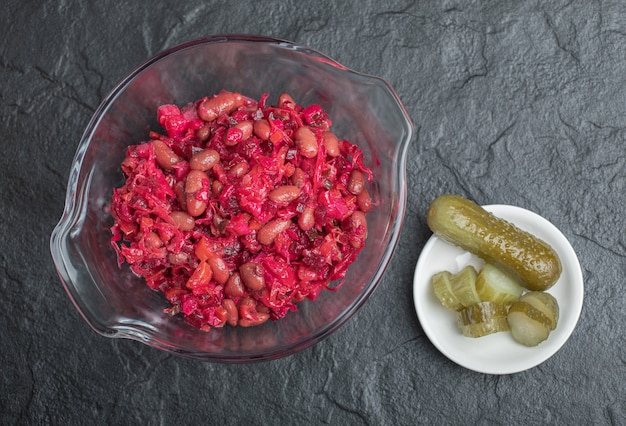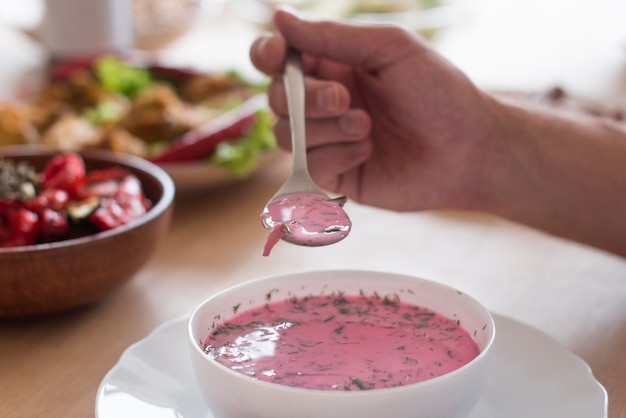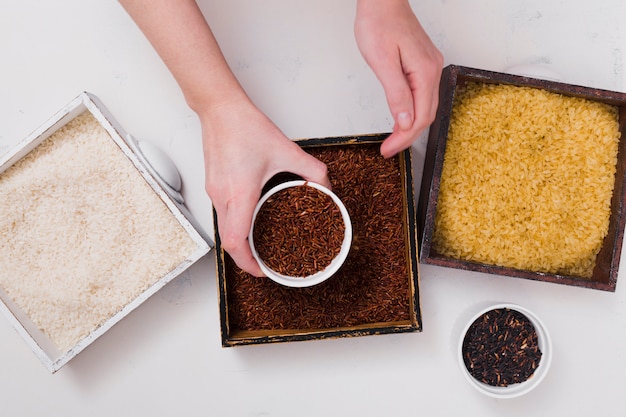You know those tiny, nutty-tasting seeds you see in the health food aisle? Those are amaranth seeds, and they've been quietly making a comeback in the world of nutrition. I remember first discovering them years ago, intrigued by the ancient history and health benefits. Let me tell you, these little guys have become a staple in my kitchen! I've been adding them to breakfast bowls, savoury salads, even baking, and they just keep surprising me with their versatility and deliciousness. So, if you're curious about this ancient grain, let me spill the beans on everything you need to know about amaranth seeds.
(Part 1) The History of Amaranth Seeds: A Grain With Deep Roots

Amaranth is an ancient grain with a history spanning thousands of years. It's been a staple food in Mesoamerica since ancient times, and its roots go back to the Aztec civilization. Imagine, this tiny seed was so important it played a central role in religious ceremonies and was a vital food source. That's a pretty remarkable history, don't you think?
Sadly, the Spanish conquest of the Americas brought a decline in amaranth's use. It was seen as a symbol of the indigenous culture, and its cultivation was actively suppressed. This was a real blow to the grain's legacy, but luckily, it didn't disappear completely. It continued to be grown in pockets around the world, and in the 20th century, thanks to its nutritional value, it started making a comeback. Today, amaranth is experiencing a resurgence in popularity around the globe. It's a true testament to its resilience and the recognition of its remarkable benefits.
(Part 2) The Nutritional Benefits of Amaranth Seeds: A Powerhouse of Goodness

Amaranth seeds are packed with nutrients, making them a true superfood. They're not just a good source of nutrition, they're a powerhouse of goodness, offering a wide range of health benefits.
A Protein Powerhouse
Let's get down to the basics. Protein is essential for muscle growth, tissue repair, and countless other bodily functions. Well, amaranth is a fantastic source of protein, boasting around 14% protein per serving. That makes it a great choice for vegetarians and vegans, and anyone looking to boost their protein intake.
Fibre for Digestive Harmony
Another reason to love amaranth is its fibre content. It's rich in both soluble and insoluble fibre, which is a real boon for your digestive health. Soluble fibre helps lower cholesterol and regulate blood sugar levels, while insoluble fibre adds bulk to your stool and keeps things moving smoothly. It's a win-win for a healthy digestive system.
A Mineral Treasure Trove
Think of amaranth as a multivitamin in seed form! It's rich in essential minerals like iron, magnesium, calcium, and phosphorus. Iron is crucial for carrying oxygen throughout your body, magnesium is vital for muscle function and nerve health, calcium is essential for strong bones, and phosphorus supports energy production. Talk about a nutritional powerhouse!
Antioxidant Power: Protecting Your Cells
Amaranth is loaded with antioxidants, which are like tiny superheroes for your cells. They combat free radicals, those pesky molecules that can damage cells and contribute to various diseases. Antioxidants are especially important for a strong immune system. So, incorporating amaranth into your diet is a great way to boost your overall health and well-being.
(Part 3) Cooking with Amaranth Seeds: Unleashing the Versatility

You might be thinking, "Okay, this all sounds great, but how do I actually cook with amaranth seeds?" Don't worry, it's super easy! These little seeds are incredibly versatile and can be used in countless ways.
Boiling Amaranth Seeds: The Simplest Approach
This is the most straightforward way to cook amaranth. Just add one cup of seeds to three cups of water in a saucepan and bring it to a boil. Reduce the heat, cover the pan, and simmer for about 20 minutes, or until the seeds have absorbed the water and become fluffy. It's similar to cooking rice, but a bit longer.
Popping Amaranth Seeds: A Nutty Surprise
Yes, you can actually pop amaranth seeds! It's like popcorn with a nutty twist. Heat a dry pan over medium heat and add the seeds. As they heat up, they'll start to pop. Be careful though, as it can splatter. Once the popping slows down, remove the pan from the heat. It's a fun way to add a crunchy texture to your snacks or dishes.
Using Amaranth Flour: A Gluten-Free Alternative
You can find amaranth flour in health food stores, which is made from ground amaranth seeds. It's a fantastic gluten-free alternative to wheat flour, and it adds a delicious nutty flavour to baked goods. It's a bit different from traditional flour, so you might need to adjust your recipes a bit, but it's really worth experimenting with.
(Part 4) Delicious Amaranth Recipes: From Breakfast to Dinner and Beyond
Now let's get into the fun stuff – the recipes! I have a few tried-and-true favourites that showcase the unique flavour and versatility of amaranth.
Breakfast Bowl with Amaranth, Berries, and Nuts: A Nutritious Start
This is a great way to start your day with a healthy and delicious breakfast. Cook some amaranth according to the instructions above. Then, layer it in a bowl with your favourite berries, chopped nuts, a drizzle of honey or maple syrup, and a sprinkle of cinnamon. It's quick, easy, and a real energy booster.
Savoury Amaranth Salad with Roasted Vegetables: A Flavorful Mix
I love this salad for its simplicity and flavour. Roast your favourite vegetables – I love sweet potatoes, broccoli, and Brussels sprouts – and toss them with a simple vinaigrette. Then, add a cup of cooked amaranth seeds to the salad for extra texture and protein. It's a real crowd-pleaser.
Amaranth Cookies: A Nutty Twist on a Classic
Want to add a bit of a nutty flavour to your cookies? Try replacing some of the flour in your favourite cookie recipe with amaranth flour. It adds a delightful crunch and a subtle nutty taste. I love making chocolate chip cookies with amaranth flour – it's just a bit more interesting than the usual plain cookie.
(Part 5) Where to Buy Amaranth Seeds: Finding Your Local Source
You can usually find amaranth seeds in health food shops, supermarkets, and online retailers. If you're having trouble finding them locally, don't worry, there are tons of options available online. Just do a quick search and you'll find all sorts of brands and packaging options.
And, if you're feeling adventurous, you might even try growing your own amaranth! It's a relatively easy plant to grow, and it's a great way to have a fresh supply of these amazing seeds.
(Part 6) Storing Amaranth Seeds: Keeping Your Supply Fresh
Once you've got your hands on some amaranth seeds, it's important to store them properly so they stay fresh and tasty. I recommend storing them in an airtight container in a cool, dark place. They'll last for several months that way. And if you're storing them in the freezer, they'll last even longer.
(Part 7) Amaranth Seeds in Different Cultures: A Global Grain
It's fascinating to see how amaranth is used in different cultures around the world. For example, in Mexico, it's a common ingredient in traditional dishes like alebrijes and atole, both of which are made with amaranth flour and other ingredients. It's also used in various other dishes, from savoury to sweet, showcasing its versatility.
In India, amaranth is known as "rajgira" and is often used in breakfast dishes, like porridge or pancakes. It's also used in sweets and other traditional snacks. It's a real testament to the adaptability of this amazing grain.
(Part 8) The Drawbacks of Amaranth Seeds: A Few Things to Know
Let's be honest, nothing is perfect. Even amaranth, with its amazing nutritional benefits, has a few drawbacks that you should be aware of.
One potential issue is the presence of saponins. Saponins are compounds found in some plants, and they can cause digestive problems if consumed in large quantities. But don’t worry, the levels of saponins in amaranth are fairly low.
Another thing to keep in mind is that amaranth can be a bit more expensive than other grains. This is because it's not as widely produced as other grains, so the supply is a bit lower. But, I think it's worth the extra cost, considering all its nutritional benefits.
(Part 9) FAQs: Answering Your Most Common Questions
I've got some questions for you. Or, rather, I've got some questions that I get asked a lot about amaranth seeds. So, here are a few frequently asked questions and my answers.
- Is amaranth gluten-free? Yes, amaranth is naturally gluten-free. So, if you're following a gluten-free diet, it's a great choice.
- Can amaranth seeds be eaten raw? While you can technically eat amaranth seeds raw, I don't recommend it. They're quite hard and can be difficult to digest. It's best to cook them, whether by boiling or popping, to make them softer and easier to eat.
- What does amaranth taste like? Amaranth has a slightly nutty and earthy flavour. It's quite mild, so it blends well with other ingredients without overpowering the dish.
- How much amaranth should I eat? There's no hard and fast rule when it comes to how much amaranth you should eat. But, as a general guideline, I'd recommend incorporating a half cup of cooked amaranth into your diet a few times a week.
- Is amaranth better than quinoa? Both amaranth and quinoa are nutritious grains, but they have slightly different nutritional profiles. Amaranth is higher in protein and iron, while quinoa is higher in fibre and magnesium. Ultimately, the best choice for you will depend on your individual needs and preferences.
(Part 10) Final Thoughts: Embrace the Superfood
So there you have it – a complete guide to cooking with amaranth seeds. It's a truly amazing grain that's packed with nutrients and has a wonderfully versatile flavour. I really encourage you to give it a try. It's been a real game-changer for me in the kitchen, and I know it'll be a hit with you too!
Let me know if you have any other questions about amaranth. I'm always happy to help and share my experience with this fascinating superfood. Happy cooking!
Everyone is watching

How to Cook Frozen Lobster Tails Perfectly: A Step-by-Step Guide
RecipesLobster. Just the word conjures up images of lavish meals, special occasions, and a taste of luxury. But let's...

Pigs in a Blanket Cooking Time: How Long to Bake for Perfect Results
RecipesAh, pigs in a blanket. Just the name conjures up images of those delightful little parcels of crispy pastry en...

Pork Fillet Cooking Time: How Long to Cook It Perfectly
RecipesPork fillet, or tenderloin as it's sometimes called, is a real favourite in our house. It's so versatile, and...

The Ultimate Guide to Cooking Delicious Frankfurters
RecipesLet's face it, we all love a good frankfurter. It's a classic, simple, and always satisfying. But let's be rea...

Wolf Meat Recipes: A Guide to Cooking Wild Game
RecipesLet's be honest, you don't see wolf meat at your local butcher shop every day. It's a bit of a wild card, but ...
